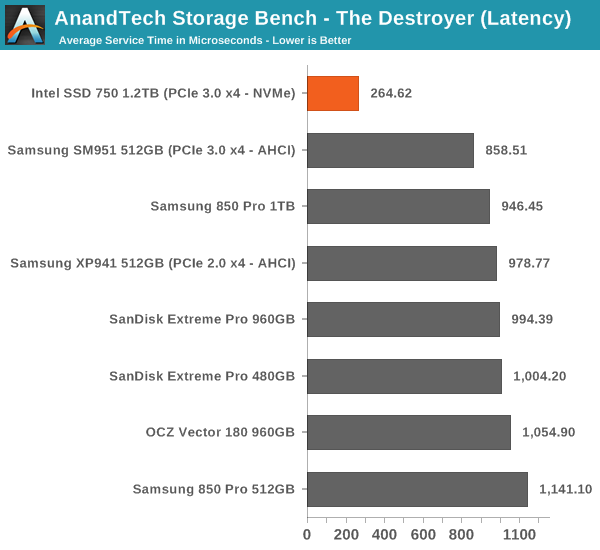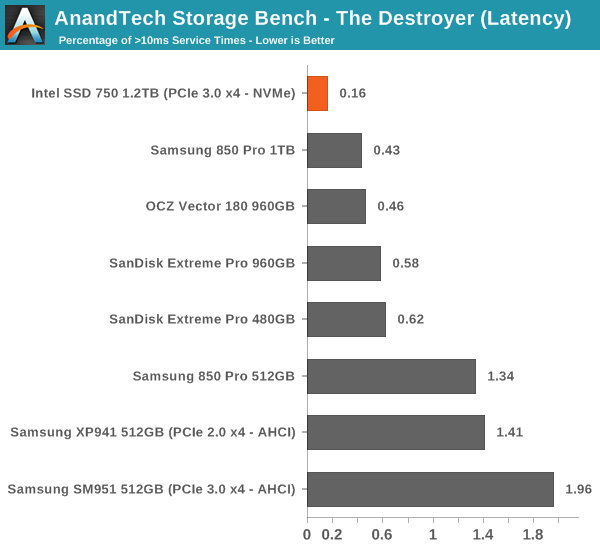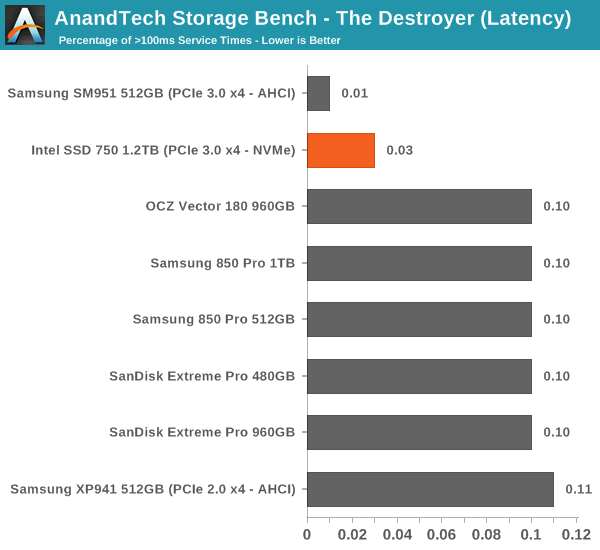Intel SSD 750 PCIe SSD Review: NVMe for the Client
by Kristian Vättö on April 2, 2015 12:00 PM ESTAnandTech Storage Bench - The Destroyer
The Destroyer has been an essential part of our SSD test suite for nearly two years now. It was crafted to provide a benchmark for very IO intensive workloads, which is where you most often notice the difference between drives. It's not necessarily the most relevant test to an average user, but for anyone with a heavier IO workload The Destroyer should do a good job at characterizing performance.
| AnandTech Storage Bench - The Destroyer | ||||||||||||
| Workload | Description | Applications Used | ||||||||||
| Photo Sync/Editing | Import images, edit, export | Adobe Photoshop CS6, Adobe Lightroom 4, Dropbox | ||||||||||
| Gaming | Download/install games, play games | Steam, Deus Ex, Skyrim, Starcraft 2, BioShock Infinite | ||||||||||
| Virtualization | Run/manage VM, use general apps inside VM | VirtualBox | ||||||||||
| General Productivity | Browse the web, manage local email, copy files, encrypt/decrypt files, backup system, download content, virus/malware scan | Chrome, IE10, Outlook, Windows 8, AxCrypt, uTorrent, AdAware | ||||||||||
| Video Playback | Copy and watch movies | Windows 8 | ||||||||||
| Application Development | Compile projects, check out code, download code samples | Visual Studio 2012 | ||||||||||
The table above describes the workloads of The Destroyer in a bit more detail. Most of the workloads are run independently in the trace, but obviously there are various operations (such as backups) in the background.
| AnandTech Storage Bench - The Destroyer - Specs | ||||||||||||
| Reads | 38.83 million | |||||||||||
| Writes | 10.98 million | |||||||||||
| Total IO Operations | 49.8 million | |||||||||||
| Total GB Read | 1583.02 GB | |||||||||||
| Total GB Written | 875.62 GB | |||||||||||
| Average Queue Depth | ~5.5 | |||||||||||
| Focus | Worst case multitasking, IO consistency | |||||||||||
The name Destroyer comes from the sheer fact that the trace contains nearly 50 million IO operations. That's enough IO operations to effectively put the drive into steady-state and give an idea of the performance in worst case multitasking scenarios. About 67% of the IOs are sequential in nature with the rest ranging from pseudo-random to fully random.
| AnandTech Storage Bench - The Destroyer - IO Breakdown | |||||||||||
| IO Size | <4KB | 4KB | 8KB | 16KB | 32KB | 64KB | 128KB | ||||
| % of Total | 6.0% | 26.2% | 3.1% | 2.4% | 1.7% | 38.4% | 18.0% | ||||
I've included a breakdown of the IOs in the table above, which accounts for 95.8% of total IOs in the trace. The leftover IO sizes are relatively rare in between sizes that don't have a significant (>1%) share on their own. Over a half of the transfers are large IOs with one fourth being 4KB in size.
| AnandTech Storage Bench - The Destroyer - QD Breakdown | ||||||||||||
| Queue Depth | 1 | 2 | 3 | 4-5 | 6-10 | 11-20 | 21-32 | >32 | ||||
| % of Total | 50.0% | 21.9% | 4.1% | 5.7% | 8.8% | 6.0% | 2.1% | 1.4% | ||||
Despite the average queue depth of 5.5, a half of the IOs happen at queue depth of one and scenarios where the queue depths is higher than 10 are rather infrequent.
The two key metrics I'm reporting haven't changed and I'll continue to report both data rate and latency because the two have slightly different focuses. Data rate measures the speed of the data transfer, so it emphasizes large IOs that simply account for a much larger share when looking at the total amount of data. Latency, on the other hand, ignores the IO size, so all IOs are given the same weight in the calculation. Both metrics are useful, although in terms of system responsiveness I think the latency is more critical. As a result, I'm also reporting two new stats that provide us a very good insight to high latency IOs by reporting the share of >10ms and >100ms IOs as a percentage of the total.

In terms of throughput, the SSD 750 is actually marginally slower than the SM951, although when you look at latency the SD 750 wins by a large margin. The difference in these scores is explained by Intel's focus on random performance as Intel specifically optimized the firmware for high random IO performance, which does have some impact on the sequential performance. As I've explained above, data rate has more emphasis on large IO size transfers, whereas latency treats all IOs the same regardless of their size.

The number of high latency IOs is also excellent and in fact the best we have tested. The SSD 750 is without a doubt a very consistent drive.












132 Comments
View All Comments
perula - Thursday, April 9, 2015 - link
[For Sell] Counterfeit Dollar(perula0@gmail.com)Euro,POUNDS,PASSPORTS,ID,Visa Stamp.Email/ perula0@gmail.com/
Text;+1(201) 588-4406
Greetings to everyone on the forum,
we supply perfectly reproduced fake money with holograms and all security features available.
Indistinguishable to the eye and to touch.
also provide real valid and fake passports for any country
delivery is discreet
We offer free shipping for samples which is 1000 worth fake as MOQ
oddbjorn - Tuesday, April 14, 2015 - link
I just recieved my 750 yesterday and soon found myself slightly bummed out by the lacking NVMe BIOS-support in my ASUS P8Z77-V motherboard. I managed to get the drive working (albeit non-bootable) by placing it in the black PCIe 2.0 slot of the mainboard, but this is hardly a long term solution. I posted a question to the https://pcdiy.asus.com/ website regarding possible future support for these motherboards and this morning they had publised a poll to check the interest for BIOS/UEFI-support for NVMe's. Please vote here if you (like me) would like to see this implemented! https://pcdiy.asus.com/2015/04/asus-nvme-support-p...Elchi - Wednesday, April 15, 2015 - link
If you are a happy owner of an older ASUS MB (z77, x79, z87) please vote for NVme support !http://pcdiy.asus.com/2015/04/asus-nvme-support-po...
iliketoprogrammeoo99 - Monday, April 20, 2015 - link
hey, this drive is now on preorder at amazon!http://amzn.to/1DDKwoI
only $449 on amazon.
vventurelli74 - Monday, May 4, 2015 - link
Lets say I had an Intel 5520 Chipset based computer that has multiple PCIe 2.0 Slots. I would be able to get almost the maximum read performance (Since PCIe 2.0 is 500MB/s per 1X, 4X = 2000MB/s, which is exciting on an older computer. I am curious as to if this would be a bootable solution on my desktop though. With 12 Cores and 24 Threads, this computer is far from under-powered, and it would be nice to breath life into this machine, but the BIOS would have no NVMe support that I can think of. I know it has Intel SSD support, but this is from a different era. I wish someone could confirm that this either will, or will not be bootable on non-MVMe mobo's. I am getting conflicting answers.vventurelli74 - Monday, May 4, 2015 - link
Nevermind, finally found the requirements that this drive will not be bootable on on NVMe machines, whats more is even using it as a 'secondary' drive requires UEFI apparently. My computer wouldn't be able to use this card at all? That would suck.xyvyx2 - Friday, May 8, 2015 - link
Great review!Kristian, any chance you have two of these drives in the same machine & you could test RAID0 performance? I'm running into some slow read performance when using two Samsung PCIe drives in a Dell server w/ a RAID1 or RAID0 config. It's not like regular bottlenecking where you hit a performance cap, but where transfer rate drops down to ~ 1/5th the speed at a lower xfer rate.
I thought this was just a Storage Spaces problem, but the same holds true w/ regular windows software raid. I got up to about 4,200 MB/sec, then it tanked. I then ran two simultaneous ATTO tests on two of the drives and they both behaved normally & peaked at 2,700 MB/sec... so I don't think I'm hitting a PCIe bus limitation... I think it's all software.
I posted more detail on Technet here:
https://social.technet.microsoft.com/Forums/en-US/...
shadowfang - Saturday, September 26, 2015 - link
How does the pcie card perform on a system without nvme?